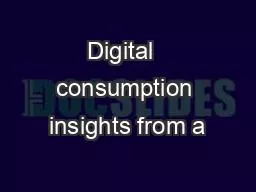

copyright infringement survey creativepec nestauk Online culture consumption patterns Trends in consumption Demographic differences Platforms User overlap Trends in consumption How do people access the Internet ID: 787901
Download The PPT/PDF document "Digital consumption insights from a" is the property of its rightful owner. Permission is granted to download and print the materials on this web site for personal, non-commercial use only, and to display it on your personal computer provided you do not modify the materials and that you retain all copyright notices contained in the materials. By downloading content from our website, you accept the terms of this agreement.
Slide1
Digital consumption insights from a copyright infringement survey
@creativepec @nesta_uk
Slide2Online culture consumption patterns
Trends in consumptionDemographic differences
Platforms
User overlap
Slide3Trends in consumption
Slide4How do people access the Internet?
Slide5What and how do people consume?
Slide6Digital consumption is increasingly spread across
multiple devices and venues.In 2018, the most
popular modes
of Internet access are still at home (87%) and on mobile phones (59%).
Tablet
Internet access increased from 27% (2014) to 48% (2017).
Smart TV
Internet access increased from 10% (2014) to 26% (2017).
Streaming is more popular than downloading or sharing. In 2018, 70% of respondents said they have streamed/ accessed some media digitally in the last 3 months. This eclipses downloading (50%) and sharing (25%). Music tracks/ albums: decrease in downloading, increase in streaming.Biggest jump in consumption: streaming full-length films (15% in 2014 → 26% in 2018). The most common type of media shared is short video clips, at 6% in 2018.
Key takeaways
Slide7Demographic differences
Slide8This shows
demographic differences in consumption of music in 2018. It includes streaming, downloading, and sharing. Note the log scale and that these differences may not be significant.
Slide9Platforms
Slide10Usage
In 2018:
People report
highest use for film, TV, music, and multimedia
platforms.
In comparison,
fewer
people report using platforms for
video games, digital images, or books.
Slide11Awareness
From 2014 to 2018:
Well-known music platforms increased from 2 to 4
:
YouTube & Spotify joined by
Apple Music & Amazon Music.
Others
have dropped out of the top:A DVD-by-mail company (LoveFilm) foldedPlay.com
Slide12In 2018, on average (median), people said
they used 3 platforms in the last 3 months, and thatthey were aware of 10 platforms
.
Some platforms are not as well-known but relatively a greater portion of people who know it also use it. E.g.
Illegal consumption (Putlocker, WatchFree)
Video games (Origin, Steam)
Some platforms are relatively well-known but not well-used. E.g.
Younger music platforms (Apple Music)Using vs being aware
Slide13YouTube was the most well-used digital consumption platform in the UK in 2018.
Others in the top 5: Amazon, Netflix, BBC iPlayer, Spotify
.
But the BBC iPlayer became the most well-known platform (67%) in the UK in 2018.
Tools
for
film, TV, music & multimedia
are top of the list.
They tend to be more commonly used and known than platforms for video games, digital images, or books. People are aware of at least twice as many platforms as they use.In 2018, people report being aware of 10 platforms whereas using only 3. Can this data be used to understand potential digital consumers and emerging platforms?Key takeaways
Slide14User overlap
Slide15Like attracts like:
Big platforms that provide music, games, videos, etc
(
Facebook,
Android, Apple, Microsoft, Amazon)
Broadcaster video-on-demand (BVOD)
(BBC, ITV, C4, C5)
& subscription VOD
(Now, Netflix)
Opposites attract: Significant ties across media types, e.g. MUBI (film) ⇄ Bookmate (books) ⇄ Green man gaming (games) ⇄ etc.
Slide16Key takeaways
The are clusters of platforms that people often use together.
They tend to provide the same type of content, e.g.
VOD services
(BBC, ITV, Channel 4) or
mega, multi-provision platforms
(Apple, Google, Microsoft App Stores, Facebook).
But d
igital consumption
mostly does not occur in silos. Music platforms compete with film/TV streaming platforms, which compete with video gaming platforms, etc for users’ time.E.g. "We compete with (and lose to) Fornite more than HBO." - Netflix 2019 Earnings Report.
Slide17Digital consumption is increasingly spread across multiple devices and venues.
Streaming is more popular than downloading or sharing. YouTube was the most well-used digital consumption platform in the UK in 2018.
Tools for
film, TV, music & multimedia
are more well-known than those for video games, digital images, or books.
People are
aware of at least twice as many
platforms as they use
.There are clusters of platforms that people often use together, but digital consumption mostly does not occur in silos of content types.Conclusions
Slide18Raphael Leungraphael.leung@nesta.org.uk